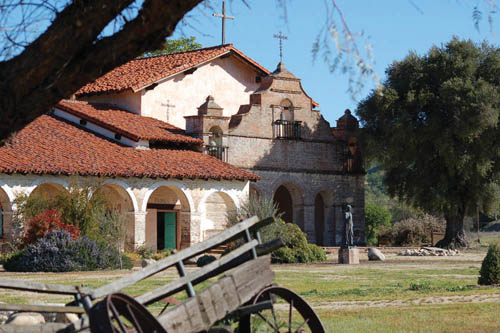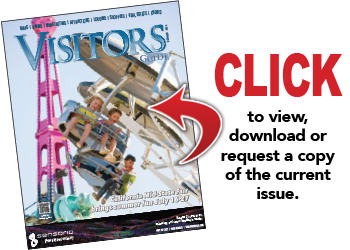
Imagine it is 1771 and you are traveling in the party of Padre Junipero Serra. You have traversed the lower section of Alta California on El Camino Real, The Royal Road, first established by Portola when he journeyed from the Mexican border to Monterey. Your journey today is through the oak-studded hills and valleys to an area six miles from present day Jolon where Father Serra plans to build his third mission church. The local residents are Indians from the Salinan tribe along with some Yokuts and Esselen that for the most part appear friendly. At a particular location, the party makes camp and Father Serra, along with Fathers Miguel Pieras, and Buenaventura Sitjar string up a set of bells across the limb of one the oaks. “This is the place,” Father Serra proclaims, “for Mission San Antonio de Padua.”
The mission church, named in honor of Saint Anthony of Padua, Italy, patron saint of things that are lost, is still today an active Catholic parish and is perhaps the only California mission site that appears much as it did when it was first built.
If you go, you will enjoy the ride out to the mission as it is back roads all the way, and should you happen to do it in springtime you will see acres of fields and hills covered with goldfields, poppies, lupine and owl’s clover.
For some reason the mission earned the nickname “Mission of the Sierras” although it is certainly nowhere near those mountains, but as you drive due west you will be looking straight at the Santa Lucia Mountains. It was a prime location back in 1771, only three miles from the San Antonio River which became the source for water for the fields of grain that the padres had the Indians produce. A sophisticated water system for its time was erected and you can still see the stone aqueducts they built on the mission grounds.
Padre Serra left this mission in the hands of his two companion friars and Father Sitjar remained there for more than 37 years. In that time he was responsible for developing a 400-page native vocabulary that he used to instruct the Indians in the Catholic faith. Much of the success of the early mission can be credited to this man.
The mission site was moved in 1773 and a small adobe church was built. Then in 1779 a second church was built along with other buildings. A water-powered grist mill was erected and a tannery and structure to store lumber were added. Much of these structures still exist or have been restored and are part of the mission grounds tour.
Several significant things are associated with this mission. It was the site of the first Christian marriage between a Salinan Indian woman and Spanish soldier in Alta California in 1773, it had the highest Native American population by 1806 of approximately 1300, and it had the first fire-tiled roof in the area.
The final mission church was erected in 1810 and was known as the Great Church. In 1834 the mission was secularized and fell into disrepair but it was returned to the Catholic Church in 1863. Beginning in the early 1900s restoration projects were begun by the California Landmark League and ultimately Franciscan friars were placed back in ministry at the mission.
Although no large town ever grew up around the mission, the area ultimately became part of William Randolph Hearst’s vast estate until he sold a large portion of it in 1940 to the United States Army. This became Fort Hunter Liggett to train troops for World War II. At present, visitors must enter through the military gate post to get to the mission.
The 1906 earthquake damaged the mission buildings but the Franciscans continued restoration projects that ultimately took 50 years to accomplish. Presently the State of California is requiring earthquake retrofitting to be completed by 2015 or the site will be closed.
The mission holds several fundraising events throughout the year to raise funds for the retrofit. On the second Sunday in June the annual Fiesta is held to honor the feast of Saint Anthony. Following mass at 11 Am a procession proceeds to the Fiesta grounds where an oak-fired barbecue takes place. Local bands play and there is dancing and games. Food is $12 a plate.
A spaghetti dinner takes place on January 26, 2013 from 11am-3 Pm where volunteers cook up pasta dinners including garlic bread and salad for $10 a plate.
Mission Days, a family event, will take place on April 6, 2013. This is a re-enactment of early mission times with people in traditional dress. There will be contests between soldiers and vaqueros on horseback. Artisans will demonstrate adobe brick making, weaving, tortilla making, acorn grinding, bead making, rope making, and more. Music, that was always important at the historical mission, will be represented by an appearance of the New World Baroque Orchestra playing original music composed for the mission and at the mission. Parking is $10 and mission-era food is $10 a plate.
Coming up soon is the Evening In The Garden event on Saturday, November 3, 2012 from 4 Pm to 8 Pm Local wineries will offer tastings of their special vintages along with specially selected catered gourmet food in the Padre’s Garden. Cost is $40 pre-sale and $50 at the door.
There is a gift shop on the mission grounds as well as a museum and tours are available. It is advisable to call for hours at 831-385-4478.
— Ruth Ann Angus











